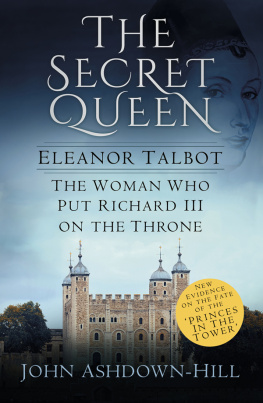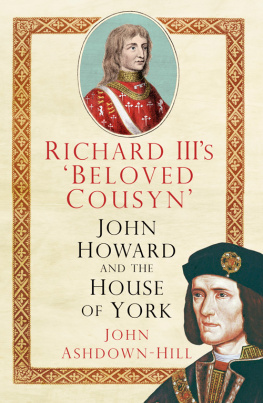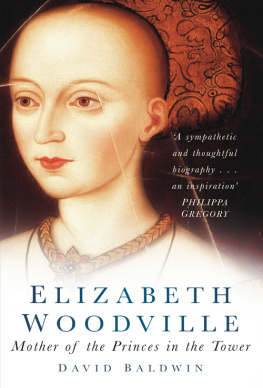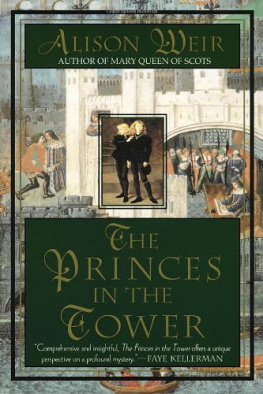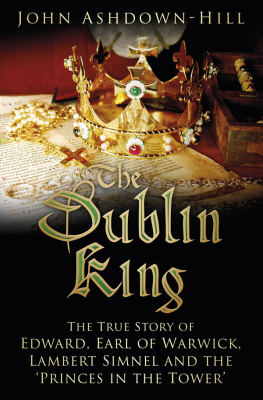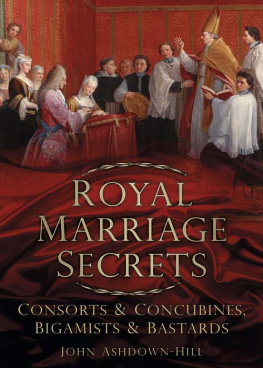
The queen [Elizabeth Widville] then remembered the calumnies with which she was reproached, namely that according to established usage she was not the legitimate wife of the king.
Domenico Mancini, 1483.
King Edward was and stoode marryed and trouth plight to oone Dame Elianor Butteler, doughter of the old Earl of Shrewesbury.
Act of Parliament, 1484.
The bishop [of Bath and Wells] said that he had married them when only he and they were present.
Philippe de Commynes, c. 1490.
Edward [IV] had espoused another wife before the mother of Elizabeth of York.
Eustace Chapuys to Emperor Charles V, 1533.
There are no sufficient grounds for regarding [the marriage between Edward IV and Eleanor Talbot] as a mere political invention Perhaps rather an evidence of the truth of the story is the care afterwards taken to suppress and to pervert it.
James Gairdner, 1898.

In memory of my cousin, Sheila Llewellyn.
Cover illustrations: Tower of London (iStockphoto/Songquan Deng); Eleanor as she may have looked in about 1462. An image based on the 1996 facial reconstruction of CFII ( Mark Satchwill, 2008)
First published in 2009
The History Press
The Mill, Brimscombe Port
Stroud, Gloucestershire, GL5 2QG
www.thehistorypress.co.uk
This ebook edition first published in 2016
All rights reserved
John Ashdown-Hill, 2009, 2010, 2016
The right of John Ashdown-Hill to be identified as the Author of this work has been asserted in accordance with the Copyright, Designs and Patents Act 1988.
This ebook is copyright material and must not be copied, reproduced, transferred, distributed, leased, licensed or publicly performed or used in any way except as specifically permitted in writing by the publishers, as allowed under the terms and conditions under which it was purchased or as strictly permitted by applicable copyright law. Any unauthorised distribution or use of this text may be a direct infringement of the authors and publishers rights, and those responsible may be liable in law accordingly.
EPUB ISBN 978 0 7524 6895 2
Original typesetting by The History Press
eBook converted by Geethik Technologies
CONTENTS
INTRODUCTION
E leanor Talbot was the rock upon which the royal house of York foundered. Unwittingly and surely, for her part, unintentionally, she brought about the downfall of the dynasty. Her relationship with Edward IV ultimately shook the crown of England so severely that it dropped into the lap of the improbable Henry Tudor (Henry VII), remotely and illegitimately descended from Edward III. What the lovely Eleanor would have thought of that outcome is anybodys guess (though her younger sister Elizabeth, who lived into Henry VIIs reign, seems not to have been one of his fans).
Eleanor brought about this dramatic outcome unintentionally. The problem arose because the Yorkist claim to the throne was founded on the concept of legitimacy. In 1399 Richard II had been deposed by his cousin Henry IV. The Lancastrian branch of the royal family thus usurped the throne, breaking the direct line of the royal succession. The Yorkist princes subsequently argued that, as the senior living descendants of Edward III, their right to the crown was superior to that of their Lancastrian cousins. Legitimacy constituted the foundation of their claim. However, that legitimacy was inevitably compromised when questions arose as to whom Edward IV had married, and whether his son and supposed heir was a bastard. It was Edward IVs relationship with Eleanor that gave rise to such questions.
In an attempt to save the Yorkist day, the crown was ultimately passed to Edwards undoubtedly legitimate surviving younger brother, Richard III. But Richard, too, found himself entangled in the web of uncertainty, since those who chose to accept the legitimacy of Edward IVs children viewed Richards accession as a usurpation. From the moment Edward IVs marriage had been seen as questionable, the house of York (hitherto so secure in the purity of its bloodline) found itself confronting a contentious and uncertain future. Indeed, the dynasty became rent by internal divisions, and Edward IV found himself obliged to execute his own brother, the Duke of Clarence.
Until the first edition of this book was published, very little was generally known about Eleanor Talbot. Even her parentage was a matter of dispute. Yet Eleanors Talbot surname and her paternity are absolutely key issues. In a fifteenth-century context, the fact that she was the daughter of the first Earl of Shrewsbury was highly significant. Lord Shrewsbury was regarded as a towering figure and a national hero. Thus, when the Act of Parliament of 1484 explicitly characterised Eleanor as his daughter, the effect of this was akin to that of a late twentieth-century writer describing someone as a daughter of Sir Winston Churchill. Eleanors rank and her plausibility as a potential royal consort were immediately established beyond any question.
The only possible way to tell Eleanors story is to seek to do what has never previously been done to bring all the facts into the light of day. As a distinguished archaeologist has written, to start to understand what happened in a particular place long ago ... we must first list exactly what we find if I misinterpret the evidence, at some point I shall discover something that will prove my lines of research are wrong the facts will not fit. A great deal of evidence is there to be found, if one looks for it.
It seems strange that Eleanors story was so long neglected and that her name is still unknown to many people. She is, in her own way, a key figure of English history, a veritable Cleopatras nose. Englands monasteries, still undissolved, could have preserved to the present day their unrivalled cultural heritage. No Tudors would mean no Stuarts; no Civil War; no Oliver Cromwell. The story goes on and on. It all turns on Eleanor.
Some readers may be surprised that the title of this book assigns Eleanor a royal title. It is true that during her lifetime she was never acknowledged as queen. However, by explicitly recognising the legitimacy of Eleanors marriage to Edward IV, while at the same time specifically denying the rank of queen to Elizabeth Widville, the Act of Parliament of 1484, known as titulus regius, implicitly accorded posthumous queenship to Eleanor. Henry VIIs subsequent repeal of this Act and his reinstatement of Elizabeth Widvilles royal rank may seem to leave Eleanor in a kind of royal limbo. Nevertheless, the subsequent marital shenanigans of Henry VIII he only recognised two of his alleged marriages on his deathbed apparently does not preclude all six of his putative spouses from still rejoicing in the title of queen.
This is an updated version of my first attempt to tell the full story of fifteenth-century Englands secret queen. Fifteen years ago, much of the information presented here was either undiscovered or unacknowledged. Unfortunately, despite the discoveries which have been made, a complete picture of Eleanor as a person will probably still fail to emerge. However, this is a feature which is by no means unique to Eleanor. Many other important characters of fifteenth-century English history including King Edward IV himself remain somewhat mysterious figures.
In the main body of the text, quotations from fifteenth-century documents in English have generally been modernised in respect of spelling and punctuation. In the presentation of documentary evidence in Appendix 1, original spellings are retained, though contractions are expanded without comment and there is some modernisation of punctuation. In keeping with good genealogical practice, the women who figure in this study are all consistently identified principally by their maiden surnames rather than their married surnames thus avoiding the widespread traditional conflict between references to Elizabeth Woodville (using her maiden name) but Eleanor Butler (using the surname of her first husband). Use of the modern spellings of both surnames has also been avoided. Although fifteenth-century spellings of these names are variable, one authentic fifteenth-century spelling of each of them has been adopted here as the standard version.
Next page
